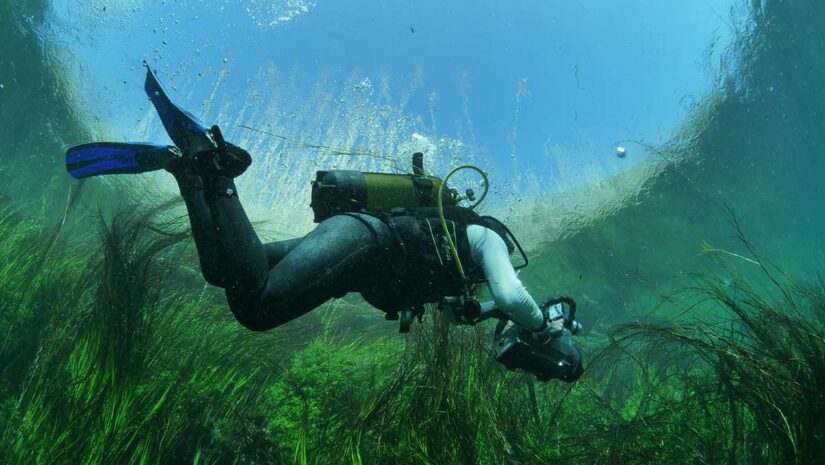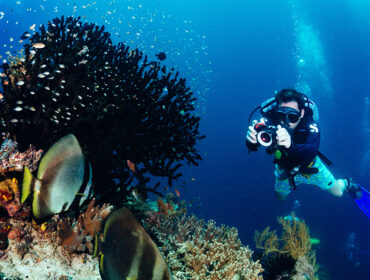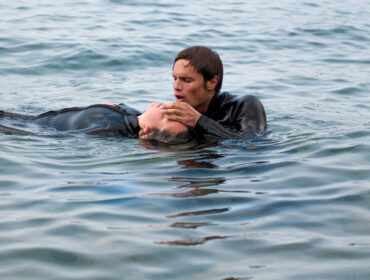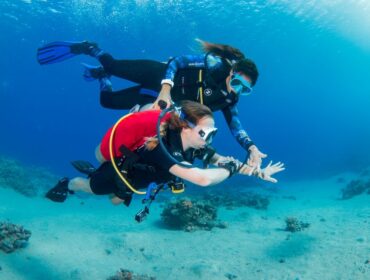Ever thought about diving in a river instead of the ocean? River diving is its own unique type of diving, and there’s a lot to learn about it! This article will tell you what river diving is, why some people love it, and the safety details you should know. We’ll list some of the best river diving locations around the world and offer tips to make your first river dive as smooth as possible. And guess what? There’s even a special river dive in the USA where you might find a Megalodon tooth!
What is River Diving?
River diving is a type of scuba diving that’s done in flowing freshwater settings as opposed to seas or lakes. Rivers, in contrast to the (often) calm waters of a reef or lake dive, contain currents that can bring an element of challenge and excitement. Divers can discover submerged trees, rocks, and even historical artifacts while river diving. However, visibility in rivers may be limited due to silt and other particles, requiring caution. Divers must also be aware of potential hazards like strong currents, underwater barriers, and rapid changes in depth. Proper training and preparation definitely are required.
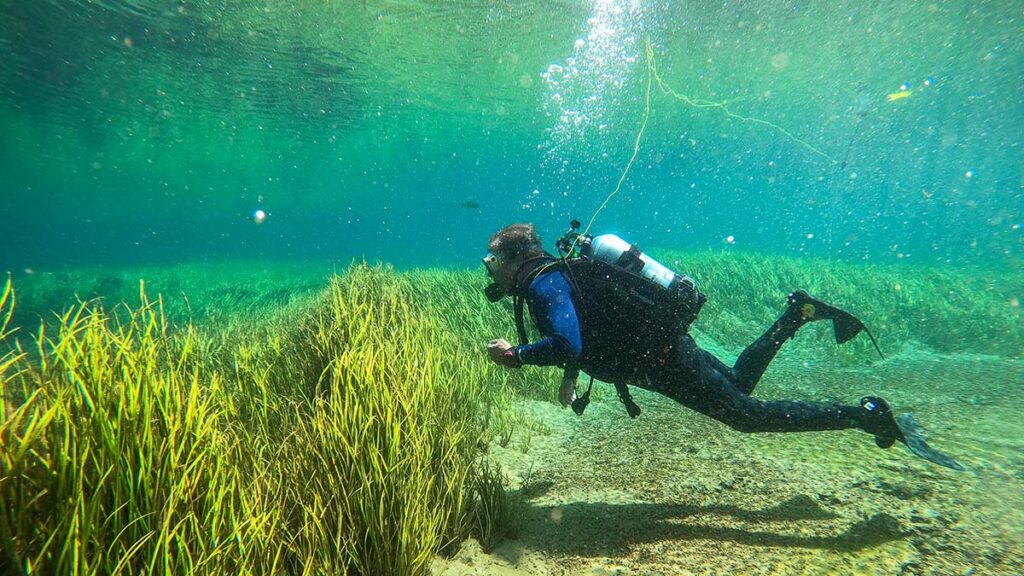
The Appeal of River Diving
River diving, while not as popular as ocean diving, has a certain appeal that has resulted in an enthusiastic following. Here’s why this sort of diving is so appealing:
Diverse Underwater Environments
Unlike the huge area of the ocean, riverbeds include a patchwork of habitats that are only a short distance apart. There’s always something new to discover just around the corner, from submerged trees and aquatic flora to rock formations shaped by the passage of water over time. Every dive is unique due to the ever-changing environment, ensuring that divers never have the same dive twice.
Rich Marine Life Diversity
While you may not come across huge sea turtles or colorful reef fish, rivers are filled with their own unique fauna. River divers get to see creatures that are rarely seen in common diving, from freshwater fish species to microscopic creatures. You might even come across freshwater eels, otters, or unusual crustaceans in specific areas.
The Challenge of the Dive
For many, the thrill of river diving is in the challenges it presents. The currents put a diver’s skills and agility to the test. River diving includes maneuvering around natural obstacles, always controlling your buoyancy, and navigating with limited visibility. Mastering these challenges can be quite rewarding giving one a sense of achievement.
Treasures from the Past
Rivers have long been important aspects of human civilization, and many historical relics have been discovered in riverbeds. Divers occasionally come across relics from the past, transforming an ordinary dive into an exciting treasure quest.
To summarize, river diving is more than just looking at what’s underwater; it’s about experiencing an environment that is constantly shifting, facing challenges, and possibly finding memories from the past. River diving provides an experience unlike any other type of diving for those looking for variety, adventure, and a dash of mystery.

River Diving for Megalodon Teeth in South Carolina
The Megalodon Shark, a massive prehistoric shark that roamed the oceans millions of years ago, left behind teeth that are a monument to its magnitude as well as a treasure for fossil hunters.
The Cooper River in South Carolina is a famous location for this unusual type of treasure seeking. This dive is difficult due to the murky waters and strong currents, but the rewards can be literally enormous. Divers frequently emerge with well-preserved teeth, some measuring 7 inches or more in length. With their razor-sharp edges and massive size, these teeth provide as a real connection to an animal that once ruled the seas.
Safety Precautions of River Diving
Exploring the world of river diving is exciting, but safety must always come first. Given the challenges provided by river environments, divers must be well-prepared and follow crucial safety precautions. Here are some important considerations:
Certifications
Make sure you have the required education and certification before going on any river diving trip. Because of the specific obstacles presented by river currents, some sites might demand trained training. A certified training will provide you with the skills and knowledge you need to deal with any potential problems.
Equipment
River diving might also need more or different equipment than ocean or lake diving. A strong dive knife can come in help with unexpected entanglements, and a brighter dive light may be essential due to the sometimes murkier waters. Before each dive, always inspect your equipment for signs of wear or damage.
River Currents & Conditions
River currents can be unexpected. It is important to understand and recognize their power. Always dive in places that are appropriate for your skill level. Consider hiring a local guide or diving with someone who knows the river well if you’re not familiar with the spot.
Because river habitats are dynamic, maintaining good communication with your diving buddy is essential. Establish a set of hand signals and always keep an eye on each other. Staying near and having a device to audibly notify (like as a shaker) might be beneficial in murkier conditions.
Do some research on the river you’re going to dive in. Understand the topography, any hazards, entry and exit points, and any local rules and regulations. Keep an eye on the weather forecast because rain can drastically change river conditions. Always inform someone on shore of your dive plans and expected return time.
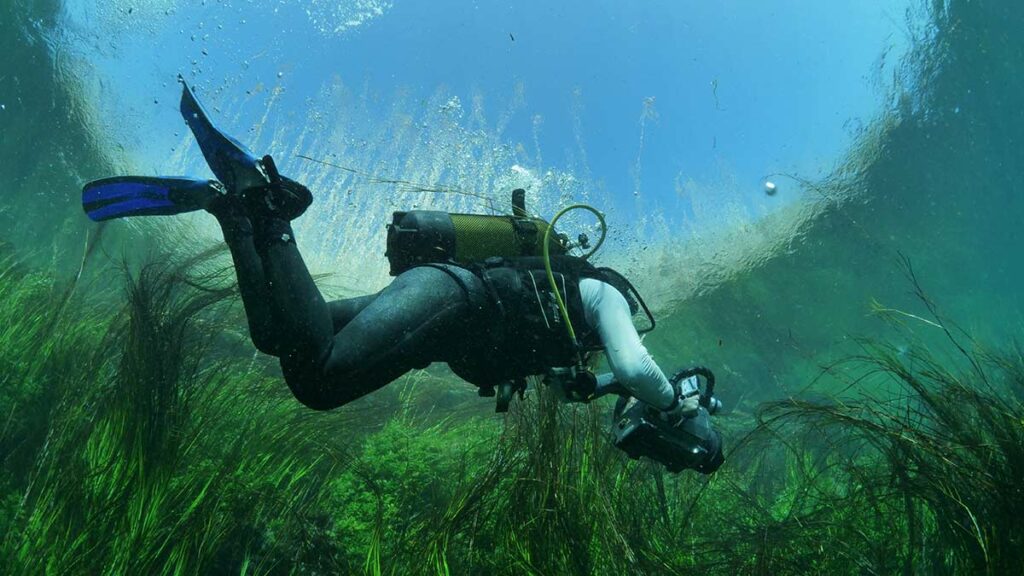
Top River Diving Destinations
River diving can be done all over the world. Here are eight of the best river diving spots that will take your breath away:
Ichetucknee Springs, Florida, USA
This crystal-clear freshwater spring in North Florida has excellent visibility. Divers can explore underground tunnels, see freshwater marine life, and get carried away by a gentle current through lush underwater vegetation.
Bonne Terre Mine, Missouri, USA
Though technically a flooded mine, Bonne Terre offers an exciting descent through abandoned mining tunnels, shafts, and machinery. The clarity of the water, along with the creepy atmosphere of an abandoned mine, creates an amazing dive.
The River Lune, England
Dive in the River Lune, which is known for its historical artifacts, to find remnants of the past. Diving between the two bridges at Devil’s Bridge is permitted during specific seasons. Since the river is a spot for salmon fishing, it’s essential to reach out to the local Tourist Information Office before planning a dive.
Verzasca River, Ticino, Switzerland
With its lovely, emerald-green waters, the Verzasca River provides an amazing diving experience. The river, which is nestled in the Swiss Alps, is noted for its smooth, polished rocks and bright aquatic sceneries. Divers can be amazed at the unusual rock formations and calm currents and the exceptional visibility, which can reach 10 meters at times. The river’s most prominent dive site, the Ponte dei Salti double-arch stone bridge, offers a stunning backdrop both above and below the water.
The Zambezi River, Zimbabwe/Zambia
Not for the faint of heart, the Zambezi River allows divers to get up close and personal with tigerfish and Nile crocodiles. The adrenaline rush of diving in such chaotic waters is just unbelievable and definitely not for everyone.
Green River, Utah, USA
The Green River is a diver’s paradise, with old fossils visible on the riverbank. It’s as if you’re diving into prehistoric times, with well-preserved relics of Earth’s distant past underneath you.
Niagara River, Canada
While the Niagara River is best known for the Niagara Falls, it also has several interesting dive locations. Even seasoned divers are challenged by strong currents and complex underwater terrain. Those who go beneath the water’s surface can see old shipwrecks, steep canyons, and a variety of freshwater fish. Because of the strong currents, diving here requires specific training and preparation.
Negro River, Brazil
The Rio Negro, one of the Amazon’s main rivers, provides a unique freshwater diving experience. The black waters of the river, colored by decomposing vegetation, create a surreal setting, with visibility changing based on rainfall and seasons. Divers can expect to see a wide variety of animals, from colorful fish to freshwater dolphins. Because of the river’s length and inaccessible stretches, each dive is an expedition into the unknown.
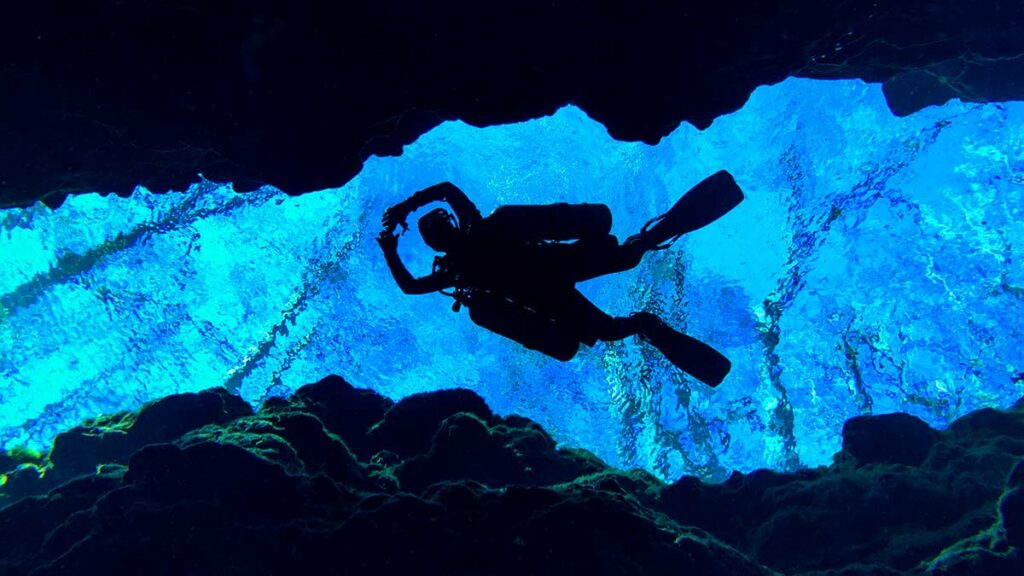
Challenges of River Diving
River diving, with its special appeal provides specific challenges that separate it from ocean or lake diving. The strong currents found in rivers are one of the most serious challenges. These unpredictable streams may change quickly, potentially confusing divers or sweeping them off their intended direction. It’s best to dive in well-known areas or with dive shops who are familiar with these specifics. Along the way, several rivers experience low visibility, particularly after storms or in locations with a lot of sediment. This murkiness makes navigating more difficult and highlights the importance of solid dive lights and excellent communication with dive buddies.
Also, rivers may consist of several kinds of natural and man-made debris, ranging from fallen trees to abandoned objects. These can become hazardous obstructions or entanglement dangers for divers, requiring a good buoyancy control and a dive knife. Plus, rivers are subject to sudden changes in conditions caused by rain, waste water, or human activity upstream. Divers must stay adaptable and conscious of their surroundings to be prepared for everything the river may throw at them.
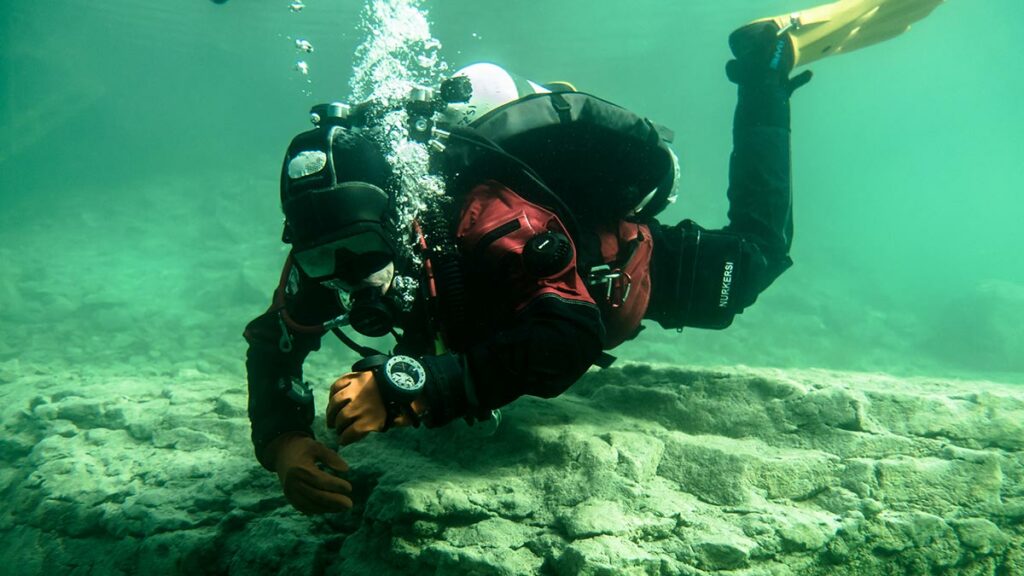
Tips for River Diving
Understand the Current
Before you dive, spend some time monitoring the flow of the river. Recognizing the strongest currents will allow you to arrange your dive more effectively and safely. Remember that currents in rivers can vary substantially in strength over short distances. Start your dive against the current whenever feasible so that if you tire or encounter difficulties, you can use the current to help you back to your starting place.
Gear Up Correctly
Riverbeds can be stony, with garbage or sharp items. To safeguard your feet, use strong dive boots. Even during the day, a decent quality dive light is needed due to the frequently limited visibility. Also, keep a cutting tool or dive knife handy in case of entanglements. Because rivers, due to their rapid water flow, can have cooler temperatures than seas or oceans, donning an adequate wetsuit or drysuit can be critical for thermal protection.
Dive with a Buddy and Communicate
Because rivers are unpredictable, having a diving partner is essential. Maintain close closeness and check in on each other on a frequent basis. Establish unambiguous communication hand signals, especially in murky waters, and always notify someone onshore of your diving plans.
Conclusion
So, there you have it – a glimpse into the world of river diving. We understand it’s not for everyone, but for those who can appreciate this adventure and can work with the challenges of river diving, there are many fantastic dives out there. And hey, if you ever come across a Megalodon tooth on a dive, remember where you first heard about it!

